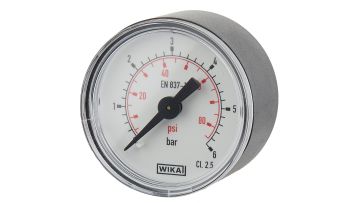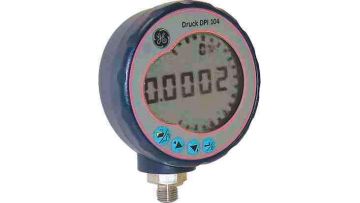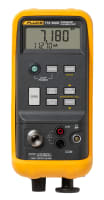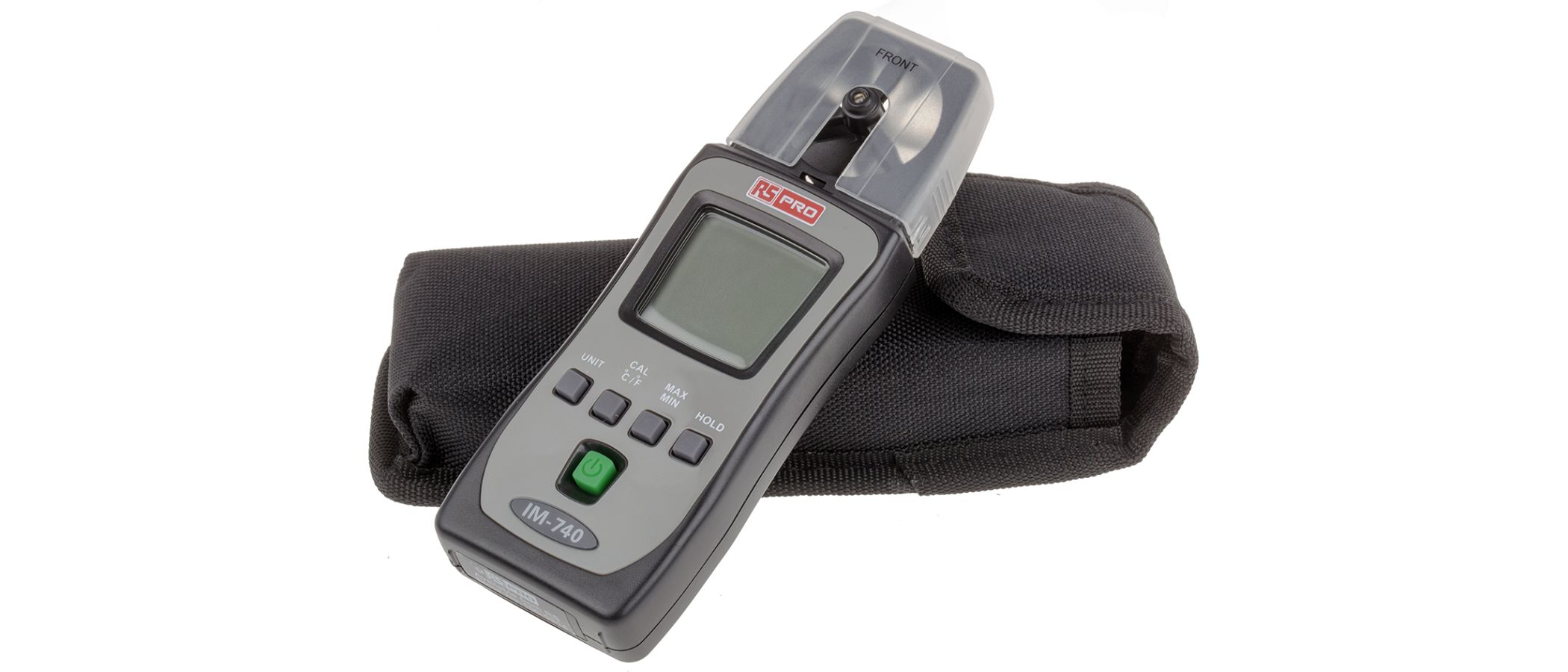Pressure Gauges – A Complete Guide
Discover everything you need to know about analogue and digital pressure gauges in our comprehensive guide.

What is a Pressure Gauge?
A pressure gauge is an instrument which measures the pressure of a gas or liquid relative to the atmosphere, a vacuum, or the difference between two points.
Pressure gauges are used across a wide range of applications and industries. There are also many different types, each best suited to specific tasks and requirements. In short, pressure gauges provide a simple, straightforward means of measuring pressure.
What is Gauge Pressure?
Gauge pressure is pressure which is relative to normal atmospheric pressure. Essentially, it is the deviation of pressure away from standard atmospheric pressure. It can be measured in several different ways, including bar and psi. Gauge pressure is commonly used worldwide, and it is also worth noting that gauge pressure can be either positive or negative.

How Does a Pressure Gauge Work?
Different types of pressure gauges work in different ways. For instance, analogue versions use a bourdon tube, whereas digital models use strain gauges. The following sections provide more detail:
How Do Analogue Pressure Gauges Work?

Analogue pressure gauges feature a curved Bourdon tube. This is a radially formed tube which features an oval cross-section. When in use, the Bourdon tube will straighten under pressure. The gas or liquid being measured presses internally on the tube, producing motion in the non-clamped tube end. This is then indicated and used to measure the pressure. The Bourdon tube is linked to the dial, and as pressure rises, the dial turns clockwise to display the pressure reading.
Shop Analogue Pressure GaugesHow Do Digital Pressure Gauges Work?

Digital pressure gauges feature a combination of microprocessors and advanced sensors. These are used to measure pressure in a highly accurate manner, clearly displaying readings on a screen or digital indicator. Many digital models use strain gauge sensors. These work by monitoring changes in electrical resistivity when pressure is applied. These changes are then measured and the results are used to calculate the pressure reading.
Shop Digital Pressure GaugesPressure Gauge Types
There are various types of pressure gauge, each best suited to particular tasks. One of the most common pressure gauge types is the traditional, round-style gauge. This is a very common, hand-held design. On the other hand, industrial process style gauges are suitable for more frequent use and heavier-duty applications.
Some of the most common pressure gauge types are explored in greater detail in the sections below:
Analogue Pressure Gauges
Analogue pressure gauges are the more traditional type. They use a needle and mechanical internals to function. Accurate and reliable, analogue auges are adaptable and can be used in many different applications. When using an analogue pressure gauge, you should aim to have your normal applied pressure to be roughly half of the full scale of the gauge.
Digital Pressure Gauges
Electronic or digital pressure gauges are more modern devices. They usually feature a diaphragm and strain gauges. They are characterised by their digital displays, which make readings easier to identify and record.
Differential Pressure Gauges
Differential pressure is the measurement of one pressure relative to another. Therefore, a differential pressure gauge works by using two ports and measuring the pressure difference between the two ports. Differential pressure can be either positive or negative.
Absolute Pressure Gauges
An absolute pressure gauge is designed to measure pressure relative to a vacuum. This means that it takes readings against either a complete or absolute vacuum. As a result, absolute pressure is always positive. These types of gauge are primarily used when working with barometers, altimeters, and atmospheric or deep vacuum equipment.
Hydraulic Pressure Gauges
Hydraulic pressure gauges offer a much higher pressure range. With some models, it can be in the high hundreds of bar. Hydraulic gauges should be used with oil.
Atmospheric Pressure Gauges
An atmospheric pressure gauge is used to measure air pressure. These instruments are primarily used by meteorologists. They can be useful for helping to predict weather patterns and provide data for weather forecasting.
Pressure Gauge Manufacturers
Many pressure gauge manufacturers around the world offer high-quality instruments for a range of different applications. However, it is important to consider the best brand for your requirements. This is because manufacturers offer varying types, designs, and uses, so choosing the right one is imperative.
Some of the most popular pressure gauge manufacturers include:
Popular Brands
WIKA
Browse the extensive range of analogue positive pressure gauges from leading brand WIKA and shop online with RS Components.
Fluke
Leading brand Fluke offers a wide range of high-quality digital positive pressure gauges. Shop the full range online.
Bourdon
Shop Bourdon analogue positive pressure gauges and choose the best device for your requirements today.
Druck
With a variety of different types and styles available, shop the full range of Druck digital pressure gauges with RS Components.
Pressure Gauge Applications
Different types of pressure gauges are suitable for use in a wide variety of applications. They can be found in everyday, domestic equipment such as boilers, heating systems, and tyre pressure monitors, yet they are also used across a diverse range of industries, including:
-
Automotive
-
Medical
-
Food and beverage
-
Manufacturing
-
Energy
Some of the principal applications where these versatile instruments can be used are explained below:
Oil Pressure Gauges
Oil gauges are designed to measure and monitor the pressure of oil in a variety of systems and applications. One of their most common uses is measuring oil pressure in vehicle engines, yet they can also be used for various other purposes.
Oil pressure gauges are found in a variety of applications, including:
-
Automotive
-
Industrial lubrication systems
-
Cutting fluid systems
Water Pressure Gauges
Water pressure gauges are instruments used in plumbing and water systems to measure water pressure. They are primarily used within the plumbing and utility industries but can also be used for domestic purposes. Mains water gauges are designed specifically for professional use.
Air Pressure Gauges
Air pressure gauges are used for monitoring and testing pneumatic and air systems. They are suitable for use with a wide range of devices and instruments, including air compressors, air cylinders, and tyre pressure gauges.
Air pressure gauges can be used to test:
-
Fan efficiency
-
Filter conditions
-
Speed (using a pitot tube)
-
Air supply
Boiler Pressure Gauges
Boiler pressure gauges display the water pressure within a boiler or heating system. Standard boiler gauges will measure the pressure within the system against ambient pressure in the atmosphere. The water pressure within these systems is relatively low and typically should not be more than four bar.
These instruments are available as either digital or mechanical devices, providing greater flexibility. Pressure gauges designed for use with boilers typically feature larger dial sizes. This makes them easy to read from a distance which is beneficial when working in potentially small or confined areas around a boiler or heating system.
How to Install a Pressure Gauge
The exact method for installation varies from one device to the next. As there are so many different types of pressure gauge available, the instrument must be fitted according to the manufacturer’s instructions for that particular gauge.
Many pressure gauges will typically include a threaded mount. This should be either placed into a manifold or a pipe fitting, depending on the application and type of gauge. However, the location of the threads will determine how and where it can be installed.
How to Calibrate a Pressure Gauge
Calibrating a pressure gauge involves testing and correcting the accuracy of the device. It is natural for certain types of test and measurement instruments such as these to gradually decrease in accuracy over time. As a result, calibration is important for ensuring continued accurate measurements. This is especially important for applications and industries where highly precise measurements are imperative.
Pressure gauges can be calibrated in one of two ways. The first method involves sending the device to a dedicated calibration lab. This means that experts will ensure the gauge is properly and accurately calibrated. The second method requires the use of a hand-held pressure calibrator. These devices generate pressure by either a pump or a hand lever and allow the user to calibrate the gauge accordingly.

There is no required timeframe specifying when a pressure gauge should be recalibrated. Certain industries or businesses – especially those where high accuracy is key – will require more frequent recalibration than is needed for other systems.
Accuracy will vary based on several factors including:
-
The type of device
-
The quality of the device
-
What it is used for
-
How often it is used
-
The environment it is both used and stored in
-
How much time has passed since it was last calibrated
-
The age of the device
As a result, deciding when a gauge needs recalibration is the responsibility of the user. However, as a rough guide, many industrial users prefer to get their devices calibrated on an annual basis.
FAQs
How to Use a Water Pressure Test Gauge?
Water pressure gauges can be used to monitor flow rate and record water pressure.
The process for recording water pressure using a gauge is as follows:
-
To ensure an accurate measurement can be taken, turn off all taps and equipment using the water system
-
Fit the water pressure gauge to the required connection. This could be a hose, tap, or specific piece of equipment
-
Turn on the tap
-
As water passes through, the gauge will provide a water pressure measurement
A low reading could indicate the presence of a blockage, problems with pipework or the water system, or simply low water pressure in the area. Conversely, a high reading may suggest that a pressure regulator could be required to help regulate the water pressure levels.
What is the Difference Between Absolute Pressure and Gauge Pressure?
The key difference between absolute and gauge pressure is:
-
Absolute pressure uses absolute zero as the zero point
-
Gauge pressure uses atmospheric pressure as the zero point
This means that using absolute pressure as a measurement provides a more precise, accurate reading. This is because absolute zero is always the same and does not change, whereas atmospheric pressure can vary. As a result, gauge pressure measurements may not always be highly precise.
What is a Supply Pressure Gauge Used for?
Air supply pressure gauges are used to measure how much pressure is in air tanks and systems. They are used in the automotive industry for monitoring pressure in air brakes. This helps to ensure that the vehicle’s air brake system performs optimally and functions correctly.

